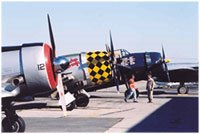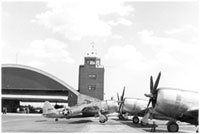
On Friday, September 4th, the American Airpower Museum in Farmingdale held a ceremony commemorating the 60th anniversary of the Berlin Airlift. In 1948/49, allied planes brought food, supplies and hope to the blockaded city of Berlin.
The Berlin Airlift was a heroic effort that saved more than two million men, women and children from starvation and death. For 322 days, in more than 270,000 flights, the airlift brought 1.7 million tons of food and supplies to the war-stricken people of Berlin. Fuelled by the will to save human lives and to preserve freedom, Berliners and Americans worked hand in hand. The Berlin Airlift united former enemies that were separated by World War II and also laid the foundation for the strong and trusted friendship between the German and American people.
Planes like the Douglas C-54 were the backbone and the workhorse of the “Big Lift”. Berliners lovingly called them “Rosinenbomber” (“Candy bombers”). One original plane, the „Spirit of Freedom“, now serves as a flying museum and was one of the highlights at the American Airpower Museum.
During the airlift, it took more than 300 aircrafts operating 24 hours a day to save the people of Berlin from starvation. Planes like the “Spirit of Freedom” (a C-54 Skymaster) could carry 10 tons of cargo. It took about 1300 C-54 flights to meet Berlin’s daily needs and almost every three minutes a plane took off to supply the blockaded city with coal and food.
Jeff Clyman, Gary Lewi and Günther Bier from the American Airpower Museum in Farmingdale welcomed veterans of the Berlin Airlift and contemporary witness Elke Mariotti, who experienced the heroic efforts as a child in Berlin. On behalf of Consul General Horst Freitag, the German Consulate was represented by Vice Consul Werner-Ciprian Fugel.
For more information, please visit the museum’s website:
www.americanairpowermuseum.com.



